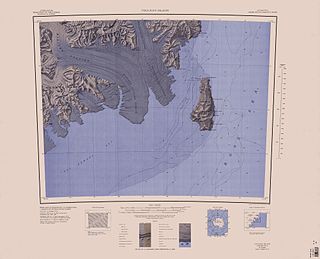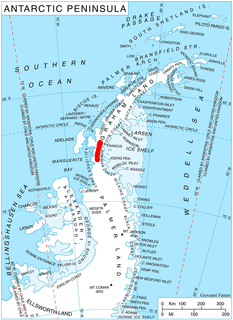Related Research Articles

Marguerite Bay or Margaret Bay is an extensive bay on the west side of the Antarctic Peninsula, which is bounded on the north by Adelaide Island and on the south by Wordie Ice Shelf, George VI Sound and Alexander Island. The mainland coast on the Antarctic Peninsula is Fallières Coast. Islands within the bay include Pourquoi Pas Island, Horseshoe Island, Terminal Island, and Lagotellerie Island. Marguerite Bay was discovered in 1909 by the French Antarctic Expedition under Jean-Baptiste Charcot, who named the bay for his wife.

Borchgrevink Glacier is a large glacier in the Victory Mountains, Victoria Land, draining south between Malta Plateau and Daniell Peninsula, and thence projecting into Glacier Strait, Ross Sea, as a floating glacier tongue, the Borchgrevink Glacier Tongue, just south of Cape Jones. It was named by the New Zealand Geological Survey Antarctic Expedition, 1957–58, for Carsten Borchgrevink, leader of the British Antarctic Expedition, 1898–1900. Borchgrevink visited the area in February 1900 and first observed the seaward portion of the glacier.

Apollo Glacier is a glacier, 9 nautical miles (17 km) long, flowing northeast and joining the lower part of Aphrodite Glacier 2 nautical miles (4 km) from the east coast of the Antarctic Peninsula.
Blümcke Knoll is a small steep-sided feature protruding through the ice of northern Adelaide Island, about 11 nautical miles (20 km) southwest of Mount Velain. It was mapped from air photos taken by the Ronne Antarctic Research Expedition (1947–48) and the Falkland Islands and Dependencies Aerial Survey Expedition (1956–57), and named by the UK Antarctic Place-Names Committee after Adolf Blümcke (1854–1914), a German glaciologist who was a professor in the Oberrealschule at Augsburg.
Buggisch Peak is a peak rising to 1,445 metres (4,740 ft), 1 nautical mile (2 km) southwest of Lester Peak, Edson Hills, in the Heritage Range, Ellsworth Mountains, Marie Byrd Land. It was mapped by the United States Geological Survey from surveys and from U.S. Navy aerial photographs, 1961–66, and named by the Advisory Committee on Antarctic Names after Werner Buggisch, a German member of the field party with the United States Antarctic Research Program Ellsworth Mountains Expedition, 1979–80, led by Gerald F. Webers.
Cavalier Rock is an isolated rock lying 13 nautical miles (24 km) southwest of Cape Adriasola, off the south part of Adelaide Island. It was named by the UK Antarctic Place-Names Committee in 1963 for Sub. Lieutenant Geoffrey A. Cavalier, Royal Navy, helicopter pilot of HMS Protector who flew the reconnaissances which located this feature.
Consul Reef is a line of drying and submerged rocks forming the south end of the Dion Islands, off the south end of Adelaide Island. It was so named by the UK Antarctic Place-Names Committee in 1963; the name extends those in the neighboring islands associated with an emperor's court.

Swithinbank Glacier is a glacier on the west side of Hemimont Plateau flowing north to the southeast corner of Square Bay, in Graham Land. Mapped by Falkland Islands Dependencies Survey (FIDS) from surveys and air photos, 1946–59. Named by United Kingdom Antarctic Place-Names Committee (UK-APC) for Charles Swithinbank, British glaciologist, a participant in several British, New Zealand and American expeditions to Antarctica, 1949–62.
Dennison Reef is a reef between the Shull Rocks and the Pauling Islands, lying east of the south end of the Biscoe Islands in Crystal Sound. It was mapped from air photos obtained by the Ronne Antarctic Research Expedition (1947–48) and from surveys by the Falkland Islands Dependencies Survey (1958–59). It was named by the UK Antarctic Place-Names Committee for David M. Dennison, a physicist who took x-ray diffraction pictures which were used to interpret the crystal structure of ice.
Knuckle Reef is a reef lying off Beacon Head, Horseshoe Island, Antarctica. The reef was so named by the UK Antarctic Place-Names Committee in 1958 because the individual rocks in the reef, which are exposed at low tide, resemble the knuckles of a clenched fist.
Fitton Rock is a flat-topped rock lying southeast of Cape Alexandra, off the south end of Adelaide Island. It was first charted by the French Antarctic Expedition, 1908–10, under Jean-Baptiste Charcot, and was named by the UK Antarctic Place-Names Committee in 1963 for Gordon F. Fitton, a British Antarctic Survey general assistant at Adelaide Station, 1961–62, and a member of the first party to winter on Adelaide Island.
The Glover Rocks are a group of rocks lying northwest of Avian Island, off the south end of Adelaide Island, Antarctica. They were named by the UK Antarctic Place-Names Committee for John F. Glover, 3rd Engineer of RRS John Biscoe (1962–63), the ship assisting the Royal Navy Hydrographic Survey Unit which charted the feature in 1963.

Lord Bank is a submarine bank in the Bellingshausen Sea with a least depth of 18 metres (60 ft) lying west-southwest of the entrance to Quest Channel, Adelaide Island, Antarctica. The bank was surveyed from HMS Endurance in January 1980 and was named by the UK Antarctic Place-Names Committee after Captain James Trevor Lord, Royal Navy, the commanding officer of HMS Endurance, 1978–80.
Lliboutry Glacier is a glacier flowing southwest from the Boyle Mountains of Antarctica into Bourgeois Fjord, Loubet Coast. It was named by the UK Antarctic Place-Names Committee in 1983 after Louis A.F. Lliboutry, a French physicist and glaciologist who investigated the mechanical deformation of ice and the micro-meteorological properties of ice surfaces, and who also made a general study of glaciers in the Antarctic Peninsula. Lliboutry was Director of the Laboratory of Glaciology, University of Grenoble, 1958–83, and President of the International Commission on Snow and Ice, 1983–87.
Himalia Ridge is a ridge running east–west on the north side of the Ganymede Heights massif, north-east of Jupiter Glacier, in the east of Alexander Island, Antarctica. It was photographed from the air by the Ronne Antarctic Research Expedition in 1947 and mapped from these photographs by D. Searle of the Falkland Islands Dependencies Survey in 1960. The ridge was named by the UK Antarctic Place-Names Committee following British Antarctic Survey geological work, 1983–84, after Himalia, a satellite of the planet Jupiter, in association with Jupiter Glacier. The site lies within Antarctic Specially Protected Area (ASPA) No.147.
Relay Hills is a group of low, ice-covered hills, mainly conical in shape, between Mount Edgell and Kinnear Mountains in western Antarctic Peninsula. First roughly surveyed from the ground by British Graham Land Expedition (BGLE), 1936–37. Photographed from the air by Ronne Antarctic Research Expedition (RARE), November 1947. Resurveyed by Falkland Islands Dependencies Survey (FIDS), November 1958. The name, applied by the United Kingdom Antarctic Place-Names Committee (UK-APC), arose because both the BGLE and the FIDS sledging parties had to relay their loads through this area to the head of Prospect Glacier.
Regent Reef is an area of submerged and drying rocks forming the northeast limit of the Dion Islands, off the south end of Adelaide Island. Charted by the Royal Navy Hydrographic Survey Unit in 1963. The name given by the United Kingdom Antarctic Place-Names Committee (UK-APC) extends those in the neighboring islands associated with an emperor's court.
Rocca Islands is a group of small islands and rocks 3 nautical miles (6 km) east of Avian Island, off the south end of Adelaide Island. Discovered in 1909 by the French Antarctic Expedition and named by Charcot for Monsieur Rocca, an acquaintance in Punta Arenas. Remapped by the British Royal Navy Hydrographic Survey Unit in 1963.
Launch Rock is a submerged rock lying southwest of the Glover Rocks, off the south end of Adelaide Island, Antarctica. It was named by the UK Antarctic Place-Names Committee to commemorate the unnamed launch from RRS John Biscoe that was used by the Hydrographic Survey Unit which charted this area in 1963.
League Rock is a distinctive rounded rock lying southwest of Box Reef, off the south end of Adelaide Island, Antarctica. It was surveyed by the Royal Navy Hydrographic Survey Unit, 1962–63, and was so named by the UK Antarctic Place-Names Committee because the rock lies one league distant from what was then Adelaide Station.
References
- ↑ "Jennings Reef". Geographic Names Information System . United States Geological Survey . Retrieved 2012-07-24.
![]() This article incorporates public domain material from the United States Geological Survey document: "Jennings Reef".(content from the Geographic Names Information System )
This article incorporates public domain material from the United States Geological Survey document: "Jennings Reef".(content from the Geographic Names Information System )
Coordinates: 67°46′S68°50′W / 67.767°S 68.833°W
| | This Adelaide Island location article is a stub. You can help Wikipedia by expanding it. |